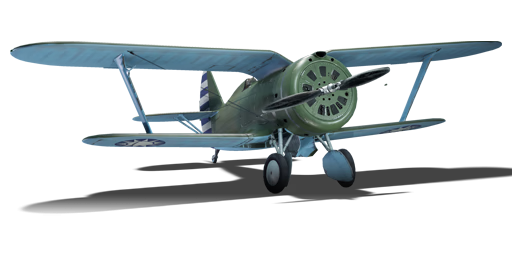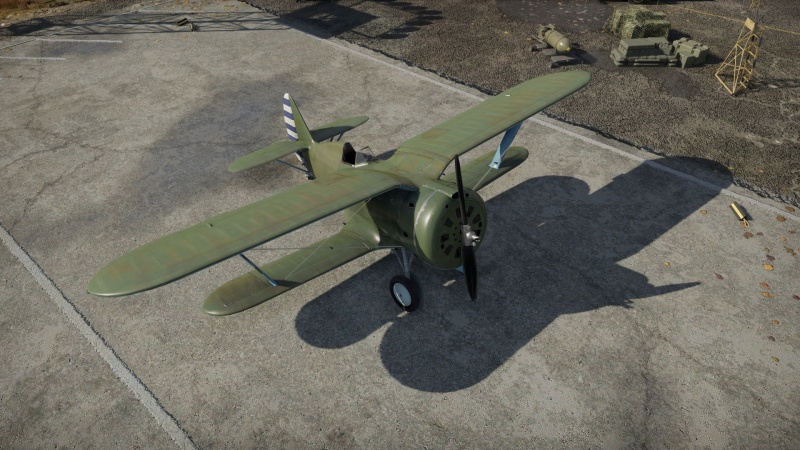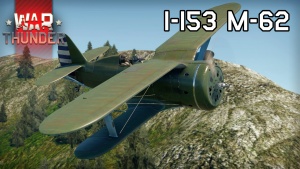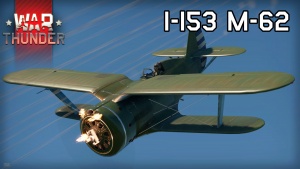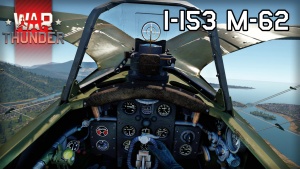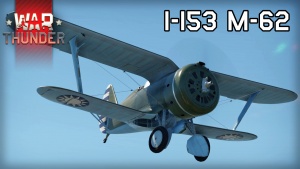Difference between revisions of "I-153 M-62 (China)"
(→Usage in battles) |
bacongaming (talk | contribs) (→Suspended armament: Added expanded/improved survivability and armament segments, also added some ingame screenshots showing the aircraft.) (Tag: Visual edit) |
||
| Line 9: | Line 9: | ||
== General info == | == General info == | ||
| − | === Flight performance === | + | === Flight performance === |
{{Specs-Avia-Flight}} | {{Specs-Avia-Flight}} | ||
<!--Describe how the aircraft behaves in the air. Speed, manoeuvrability, acceleration and allowable loads - these are the most important characteristics of the vehicle.--> | <!--Describe how the aircraft behaves in the air. Speed, manoeuvrability, acceleration and allowable loads - these are the most important characteristics of the vehicle.--> | ||
| Line 91: | Line 91: | ||
|} | |} | ||
| − | === Survivability and armour === | + | [[File:China I153 Wiki Image 1.jpg|thumb|Side view of a I-153.]] |
| + | |||
| + | === Survivability and armour === | ||
{{Specs-Avia-Armour}} | {{Specs-Avia-Armour}} | ||
<!-- ''Examine the survivability of the aircraft. Note how vulnerable the structure is and how secure the pilot is, whether the fuel tanks are armoured, etc. Describe the armour, if there is any, and also mention the vulnerability of other critical aircraft systems.'' --> | <!-- ''Examine the survivability of the aircraft. Note how vulnerable the structure is and how secure the pilot is, whether the fuel tanks are armoured, etc. Describe the armour, if there is any, and also mention the vulnerability of other critical aircraft systems.'' --> | ||
| − | + | Being a biplane the aircraft is capable of taking a few 7-8mm rounds in combat, in some cases will be able to keep flying after some hits from larger calibres. However at its battle ratting it will commonly encounter 12.7mm machine guns and 20mm cannons of which will not be kind to the Chaika. These weapons will easily inflict critical damage onto the aircraft with only a few clean hits, due to this its best to maintain good awareness and use the aircrafts highly competitive maneuverability to avoid being hit by enemy fire. | |
| − | The | + | The Chaika does feature a large 8mm steel plate behind the pilot this will provide some protection against smaller calibres when being attacked from behind, although will not offer much protection against 12.7mm and 20mm weapons. |
* 8 mm steel: behind pilot | * 8 mm steel: behind pilot | ||
| Line 115: | Line 117: | ||
* 4 x 7.62 mm ShKAS machine guns, nose-mounted (700 + 750 + 520 + 500 = 2,470 total) | * 4 x 7.62 mm ShKAS machine guns, nose-mounted (700 + 750 + 520 + 500 = 2,470 total) | ||
| − | === Suspended armament === | + | [[File:China I-153 M-62 Image 1.jpg|thumb|A Chaika fires its machine guns.]] |
| + | |||
| + | === Suspended armament === | ||
{{Specs-Avia-Suspended}} | {{Specs-Avia-Suspended}} | ||
<!-- ''Describe the aircraft's suspended armament: additional cannons under the wings, bombs, rockets and torpedoes. This section is especially important for bombers and attackers. If there is no suspended weaponry remove this subsection.'' --> | <!-- ''Describe the aircraft's suspended armament: additional cannons under the wings, bombs, rockets and torpedoes. This section is especially important for bombers and attackers. If there is no suspended weaponry remove this subsection.'' --> | ||
| Line 126: | Line 130: | ||
* 8 x RS-82 rockets | * 8 x RS-82 rockets | ||
* 8 x RBS-82 rockets | * 8 x RBS-82 rockets | ||
| + | |||
| + | The weapons on the Chaika do offer a fair bit of flexibility, the four 7.62mm Machine guns hold between 500-750 rounds of ammunition per gun with a fire rate of 1800 rounds per minute, in addition all 4 guns are mounted in the nose of the aircraft and fire through the propeller. Being mounted so close the centre line of the aircraft simplifies aiming with gun targeting distance being much less critical, the guns being so close also give a rather focused impact point something of which can be devastating if shots are hitting the target. | ||
| + | |||
| + | In addition to its guns the I-153 can used both bombs and rockets, a set of 4 FAB-50 bombs can be carried under the wings, each bomb holds 26.35kg of explosive mass which at this battle rating will be enough to critically damage or destroy ground targets with a fairly accurate drop, the aircraft will be able to carry out 2 bombing runs as the bombs drop in pairs, with the outer pair dropping first and then the inner pair. | ||
| + | |||
| + | There are two rocket types available to the Chaika and in both cases 8 can be carrier under the wings. The first type is the RS-82, a HE rocket with 0.36kg of explosive mass and 10mm of penetration, these are trumped by the RBS-82. The RBS-82 is essentially a rocket-propelled APHE Round as it can penetrate up too 60mm of armour and has 0.48kg of explosive mass so a solid hit is almost guaranteed to reward you with a kill, with 4 paired firings the RBS-82's make the I-183 a rather effective aircraft for ground battles at its battle rating and above. | ||
== Usage in battles == | == Usage in battles == | ||
| − | <!--''Describe the tactics of playing in the aircraft, the features of using aircraft in a team and advice on tactics. Refrain from creating a "guide" - do not impose a single point of view, but instead, give the reader food for thought. Examine the most dangerous enemies and give recommendations on fighting them. If necessary, note the specifics of the game in different modes (AB, RB, SB).''--> | + | <!--''Describe the tactics of playing in the aircraft, the features of using aircraft in a team and advice on tactics. Refrain from creating a "guide" - do not impose a single point of view, but instead, give the reader food for thought. Examine the most dangerous enemies and give recommendations on fighting them. If necessary, note the specifics of the game in different modes (AB, RB, SB).''--> [[File:China I-153 M-62 Wiki Image 5.jpg|thumb|The Cockpit of the I-153.]] |
| − | + | The I-153 can be used in turn fighting, bomber intercepting and ground-pounding. It is excellent in turning tightly and continuously, and it has lovely low-speed handling and low stall speeds (unlike its successor I-16), making it a great starter plane for simulator battles. However it does have its drawbacks: the rather big nose blocks the visibility a lot, offering very poor over-the-nose visibility which is a disadvantage in a turn fight, because when leading a shot the enemy will always get obstructed by the engine, making the player guess the shot. Also, its upper wings will get in the way when you look aside. | |
| − | The I-153 can be used in turn fighting, bomber intercepting and ground-pounding. It is excellent in turning tightly and continuously, and it has lovely low-speed handling and low stall speeds (unlike its successor I-16), making it a great starter plane for simulator battles. However it does have its drawbacks: the rather big nose blocks the visibility a lot, offering very poor over-the-nose visibility which is a disadvantage in a turn fight, because when leading a shot the enemy will always get obstructed by the engine, making the player guess the shot. Also, its upper wings will get in the way when you look aside. | ||
Note: it is recommended to set the convergence within 300m, with vertical convergence on, because the majority of turn fights happen at that range or closer. | Note: it is recommended to set the convergence within 300m, with vertical convergence on, because the majority of turn fights happen at that range or closer. | ||
| Line 184: | Line 193: | ||
* Favourable matchmaking allows it to fight earlier monoplanes and worse biplanes | * Favourable matchmaking allows it to fight earlier monoplanes and worse biplanes | ||
* Small target | * Small target | ||
| − | * Excellent for learning/performing highly advanced aerobatic | + | * Excellent for learning/performing highly advanced aerobatic manoeuvres |
'''Cons:''' | '''Cons:''' | ||
| Line 199: | Line 208: | ||
== History == | == History == | ||
| − | <!-- ''Describe the history of the creation and combat usage of the aircraft in more detail than in the introduction. If the historical reference turns out to be too long, take it to a separate article, taking a link to the article about the vehicle and adding a block "/History" (example: <nowiki>https://wiki.warthunder.com/(Vehicle-name)/History</nowiki>) and add a link to it here using the <code>main</code> template. Be sure to reference text and sources by using <code><nowiki><ref></ref></nowiki></code>, as well as adding them at the end of the article with <code><nowiki><references /></nowiki></code>. This section may also include the vehicle's dev blog entry (if applicable) and the in-game encyclopedia description (under <code><nowiki>=== In-game description ===</nowiki></code>, also if applicable).'' --> | + | <!-- ''Describe the history of the creation and combat usage of the aircraft in more detail than in the introduction. If the historical reference turns out to be too long, take it to a separate article, taking a link to the article about the vehicle and adding a block "/History" (example: <nowiki>https://wiki.warthunder.com/(Vehicle-name)/History</nowiki>) and add a link to it here using the <code>main</code> template. Be sure to reference text and sources by using <code><nowiki><ref></ref></nowiki></code>, as well as adding them at the end of the article with <code><nowiki><references /></nowiki></code>. This section may also include the vehicle's dev blog entry (if applicable) and the in-game encyclopedia description (under <code><nowiki>=== In-game description ===</nowiki></code>, also if applicable).'' --> [[File:China I-153 M-62 Wiki Image 3.jpg|thumb|A I-153 with its landing gear extended.]] |
| − | Since August 1937, the Soviet Union unofficially supported the Chinese Kuomintang Government against their traditional enemies, the Japanese in 1939 both selling military equipment and Russian volunteer pilots (much like America had with its AVG). Initial support was with [[I-15bis|I-15]] biplanes, but as the Japanese introduced the superior [[Ki-27 otsu|Nakajima Ki-27]] the Soviets moved to counter the new threat. | + | Since August 1937, the Soviet Union unofficially supported the Chinese Kuomintang Government against their traditional enemies, the Japanese in 1939 both selling military equipment and Russian volunteer pilots (much like America had with its AVG). Initial support was with [[I-15bis|I-15]] biplanes, but as the Japanese introduced the superior [[Ki-27 otsu|Nakajima Ki-27]] the Soviets moved to counter the new threat. |
With the Polikarpov I-15bis (second version) becoming obsolete, the Soviet military felt it was too early to abandon biplanes so they approved of an update proposed by Polikarpov. The resulting I-15, 3rd version, or [[I-153 M-62|I-153 Chaika]] (Russian Чайка, "Seagull") was, in short, an unmitigated success. Mounting a more powerful Shvetsov M-62 engine and retractable wheels (unusual for a biplane), it gained an almost 100 km/h speed advantage over its older sibling. In addition, the four slow firing PV-1 machine guns were replaced with the ShKAS machine gun which fired some 2.3 times faster, making its firepower competitive with more modern fighters of the period; however, its dominance was short lived. | With the Polikarpov I-15bis (second version) becoming obsolete, the Soviet military felt it was too early to abandon biplanes so they approved of an update proposed by Polikarpov. The resulting I-15, 3rd version, or [[I-153 M-62|I-153 Chaika]] (Russian Чайка, "Seagull") was, in short, an unmitigated success. Mounting a more powerful Shvetsov M-62 engine and retractable wheels (unusual for a biplane), it gained an almost 100 km/h speed advantage over its older sibling. In addition, the four slow firing PV-1 machine guns were replaced with the ShKAS machine gun which fired some 2.3 times faster, making its firepower competitive with more modern fighters of the period; however, its dominance was short lived. | ||
Revision as of 12:10, 3 August 2021
Contents
Description
The ␗I-153 M-62 is a rank I Chinese fighter with a battle rating of 2.0 (AB/SB) and 2.3 (RB). It was introduced in Update 1.91 "Night Vision".
General info
Flight performance
The Chinese I-153 M-62 Chaika has a really good turn radius thanks to retractable landing gear, that increases aerodynamics. This plane's battle rating makes it a match against early BF 109's and other single wing fighters. This allows the I-52 M-62 to out-turn planes at its battle rating. The plane does not come without its downsides, for example other planes at this battle rating can go faster than this plane, which you might have a difficult time keeping up with other fighters.
| Characteristics | Max Speed (km/h at 4,850 m) |
Max altitude (metres) |
Turn time (seconds) |
Rate of climb (metres/second) |
Take-off run (metres) | |||
|---|---|---|---|---|---|---|---|---|
| AB | RB | AB | RB | AB | RB | |||
| Stock | 425 | 410 | 10700 | 13.8 | 14.4 | 11.4 | 11.4 | 274 |
| Upgraded | 466 | 444 | 13.0 | 13.3 | 20.1 | 15.2 | ||
Details
| Features | ||||
|---|---|---|---|---|
| Combat flaps | Take-off flaps | Landing flaps | Air brakes | Arrestor gear |
| X | X | X | X | X |
| Limits | ||||||
|---|---|---|---|---|---|---|
| Wings (km/h) | Gear (km/h) | Flaps (km/h) | Max Static G | |||
| Combat | Take-off | Landing | + | - | ||
| 580 | 450 | N/A | N/A | N/A | ~12 | ~6 |
| Optimal velocities (km/h) | |||
|---|---|---|---|
| Ailerons | Rudder | Elevators | Radiator |
| < 180 | < 240 | < 380 | > 250 |
| Compressor (RB/SB) | ||
|---|---|---|
| Setting 1 | ||
| Optimal altitude | 100% Engine power | WEP Engine power |
| 1,530 m | 840 hp | 1,024 hp |
| Setting 2 | ||
| Optimal altitude | 100% Engine power | WEP Engine power |
| 4,200 m | 800 hp | 975 hp |
Survivability and armour
Being a biplane the aircraft is capable of taking a few 7-8mm rounds in combat, in some cases will be able to keep flying after some hits from larger calibres. However at its battle ratting it will commonly encounter 12.7mm machine guns and 20mm cannons of which will not be kind to the Chaika. These weapons will easily inflict critical damage onto the aircraft with only a few clean hits, due to this its best to maintain good awareness and use the aircrafts highly competitive maneuverability to avoid being hit by enemy fire.
The Chaika does feature a large 8mm steel plate behind the pilot this will provide some protection against smaller calibres when being attacked from behind, although will not offer much protection against 12.7mm and 20mm weapons.
- 8 mm steel: behind pilot
Modifications and economy
Armaments
Offensive armament
The I-153 M-62 (China) is armed with:
- 4 x 7.62 mm ShKAS machine guns, nose-mounted (700 + 750 + 520 + 500 = 2,470 total)
Suspended armament
The I-153 M-62 (China) can be outfitted with the following ordnance:
- Without load
- 4 x 50 kg FAB-50 bombs (200 kg total)
- 8 x RS-82 rockets
- 8 x RBS-82 rockets
The weapons on the Chaika do offer a fair bit of flexibility, the four 7.62mm Machine guns hold between 500-750 rounds of ammunition per gun with a fire rate of 1800 rounds per minute, in addition all 4 guns are mounted in the nose of the aircraft and fire through the propeller. Being mounted so close the centre line of the aircraft simplifies aiming with gun targeting distance being much less critical, the guns being so close also give a rather focused impact point something of which can be devastating if shots are hitting the target.
In addition to its guns the I-153 can used both bombs and rockets, a set of 4 FAB-50 bombs can be carried under the wings, each bomb holds 26.35kg of explosive mass which at this battle rating will be enough to critically damage or destroy ground targets with a fairly accurate drop, the aircraft will be able to carry out 2 bombing runs as the bombs drop in pairs, with the outer pair dropping first and then the inner pair.
There are two rocket types available to the Chaika and in both cases 8 can be carrier under the wings. The first type is the RS-82, a HE rocket with 0.36kg of explosive mass and 10mm of penetration, these are trumped by the RBS-82. The RBS-82 is essentially a rocket-propelled APHE Round as it can penetrate up too 60mm of armour and has 0.48kg of explosive mass so a solid hit is almost guaranteed to reward you with a kill, with 4 paired firings the RBS-82's make the I-183 a rather effective aircraft for ground battles at its battle rating and above.
Usage in battles
The I-153 can be used in turn fighting, bomber intercepting and ground-pounding. It is excellent in turning tightly and continuously, and it has lovely low-speed handling and low stall speeds (unlike its successor I-16), making it a great starter plane for simulator battles. However it does have its drawbacks: the rather big nose blocks the visibility a lot, offering very poor over-the-nose visibility which is a disadvantage in a turn fight, because when leading a shot the enemy will always get obstructed by the engine, making the player guess the shot. Also, its upper wings will get in the way when you look aside.
Note: it is recommended to set the convergence within 300m, with vertical convergence on, because the majority of turn fights happen at that range or closer.
Before engaging a fight, it is better to have an altitude advantage first. When approaching the fight try to figure out which is your teammate and which is the enemy, to avoid going for a second pass, as the energy retention of the I-153 is rather slow. Also, pick your target carefully. For easier aiming, you want to go for those less-manoeuvrable twin-engine aircraft like Ju 88 or Ki-45, or bombers if there are any. Given the bad forward visibility of the I-153, these are the best options as they are quite slow and sluggish, and are a bigger target to hit. However getting hits on them doesn't mean good damage, so you must be patient. When dealing with fighters, it is way harder to aim. The elevator control of the I-153 is extremely sensitive, giving it good manoeuvrability, but at the same time, bad handling. The I-153 will respond in a very fast turn upon moving your stick/mouse by a little bit, which makes tracking nimble planes quite hard. But once you get used to it, try to lure every enemy into a turn fight, as that is where the I-153 shines. Quite a bit of bullets are required to effectively damage the enemy so you must be patient. If you find an enemy at your 6, utilise your great roll rate to do defensive manoeuvres like scissors to make them overshoot. Or you can simply do tight turns, most monoplanes won't be able to cut inside your turn and they might disengage.
If you are not very experienced in simulator battles, you can also go for even bigger targets (bombers) for easier aiming. However, you want to be more careful when hunting bombers, since with the Sim control (whether it be mouse joystick or a real stick) the plane will manoeuvre much more gently, making itself a great target for the bomber's gunners. DO NOT follow behind a bomber's 6 unless you are sure that its tail gunners are unconscious. Chasing behind a bomber makes yourself stationary for the tail gunners, and you will be showered with bullets. Your big radial engine will usually get damaged. Instead, before attacking, get an altitude advantage over the bomber by flying around 2 km above it. The bomber should only fill up about 1/6 of your gunsight. The best position for an attack is at the bomber's high 6 so you can adjust the lead much easier. Dive at the bomber, but not directly at it, try to predict where you two will crash by imagining yourself like a missile, that's where you should aim at (deflection shooting). To maximise the damage it is better to aim for their wings and engines, as the fuselage usually soaks up quite some bullets. Only fire when the bomber passes in front of your guns. This short window might seem inadequate to do anything, but with an accurate burst on the engine, the 4 MG can at least damage it. With an engine damaged most bombers cannot go far.
Ground pounding ability is average as there is only light bombs and rockets. The 8 rockets, with accurate aiming, can destroy 4 targets, whether them be tanks or pillboxes. The small 50kg bombs can be used on light pillboxes. Once the suspended armaments are gone, the 4 MG are good for killing soft targets like trucks, artillery and AA cars.
Enemies worth noting:
Ki-27, N1K1, He 51, Gladiator, etc;
Those commonly seen planes are equally good at turn fights and will be a hard target to down since they are very small and agile. To deal with them you need to practice leading and deflection shots, plus maneuvers like barrel rolls and scissors. They still need plenty of bullets to get damaged, so these kind of targets are the hardest to kill and requires great skills from the player.
This early twin-engine plane always shows up as an AI-controlled recon aircraft that you have to down, which is a piece of good news as AI won't manoeuvre aggressively. However, this plane is extremely durable for the I-153's weak MGs. When it shows up as an AI, deflection shots are not recommended as the small shooting windows really does nothing. Instead, try disabling its 2 gunners first, then just sit behind it and burst on its wings and engines. When attacking the gunners try to not get your engine damaged by pulling evasive manoeuvres as soon as the bullets come close, since the Do 17 can outrun the I-153 in a level flight.
Manual Engine Control
| MEC elements | ||||||
|---|---|---|---|---|---|---|
| Mixer | Pitch | Radiator | Supercharger | Turbocharger | ||
| Oil | Water | Type | ||||
| Controllable | Controllable Not auto controlled |
Controllable Not auto controlled |
Controllable Not auto controlled |
Separate | Controllable 2 gears |
Not controllable |
Pros and cons
Pros:
- Fast climb rate
- Excellent manoeuvrability (Will out-turn any enemy aircraft it encounters)
- Extremely difficult to target while it is making manoeuvres
- The above point can make it hard to use boom and zoom tactics against this plane (if you see it coming)
- Great at destroying bombers with a hail of rockets and machine-gun fire
- Option to be equipped with rockets that can pierce up to 60mm of armour (Can destroy most enemy tanks in ground RB at the rank)
- Very low stall speed
- 4 x rapid firing ShKAS machine guns with large ammo reserves
- Deadly with tracer belts
- The ability to retract landing gear reduces parasitic drag, improving your energy retention
- Favourable matchmaking allows it to fight earlier monoplanes and worse biplanes
- Small target
- Excellent for learning/performing highly advanced aerobatic manoeuvres
Cons:
- Low speed compared to monoplanes
- Frail airframe, can be destroyed or crippled with a few well placed hits
- Loses a lot of performance if the engine is hit
- A single machine gun round to the engine is capable of knocking it out
- ShKAS machine guns prone to overheating
- Defensive armaments of bombers can easily wreck this aircraft's engine
- Vulnerable to boom and zoom, especially when climbing
- Not suited to head on attacks
- No self-sealing tanks
History
Since August 1937, the Soviet Union unofficially supported the Chinese Kuomintang Government against their traditional enemies, the Japanese in 1939 both selling military equipment and Russian volunteer pilots (much like America had with its AVG). Initial support was with I-15 biplanes, but as the Japanese introduced the superior Nakajima Ki-27 the Soviets moved to counter the new threat.
With the Polikarpov I-15bis (second version) becoming obsolete, the Soviet military felt it was too early to abandon biplanes so they approved of an update proposed by Polikarpov. The resulting I-15, 3rd version, or I-153 Chaika (Russian Чайка, "Seagull") was, in short, an unmitigated success. Mounting a more powerful Shvetsov M-62 engine and retractable wheels (unusual for a biplane), it gained an almost 100 km/h speed advantage over its older sibling. In addition, the four slow firing PV-1 machine guns were replaced with the ShKAS machine gun which fired some 2.3 times faster, making its firepower competitive with more modern fighters of the period; however, its dominance was short lived.
Too late to see service in the Spanish Civil War, the Chaika's baptism of fire was in Northern China where it proved its mettle versus the latest Japanese design, even proving to be better than the I-16! Although well loved by crews for its sublime combat performance, Japanese forces developed effective counter tactics and eventually it could no longer meet future performance requirements, so retirement came fast. In the end, speed was clearly more important than manoeuvrability.
The Battles of Khalkhin Gol was the one major conflict where the I-153 was extensively used against the Imperial Japanese Army Air Force. While the results were practically a tie with no change to borders, both sides lost many men and equipment scattered across the desolate lands of the Mongolian-Chinese border. Decades later, a New Zealand airplane collector recovered a number of I-15's and I-153's from the battleground and restored several of them to flying condition, now in museums around the world.
Media
Excellent additions to the article would be video guides, screenshots from the game, and photos.
See also
Links to the articles on the War Thunder Wiki that you think will be useful for the reader, for example:
- reference to the series of the aircraft;
- links to approximate analogues of other nations and research trees.
External links
| Polikarpov Design Bureau (Опытное конструкторское бюро Поликарпова) | |
|---|---|
| I-15 | I-15 WR · I-15 M-22 · I-15 M-25 · I-15bis · Krasnolutsky's I-15bis |
| I-153 | I-153 M-62 · Zhukovsky's I-153-M62 · I-153P |
| I-16 | I-16 type 5 · I-16 type 10 · I-16 type 18 · I-16 type 24 · I-16 type 27 · I-16 type 28 |
| I-180 | I-180S · I-185 (M-71) · I-185 (M-82) |
| ITP | ITP (M-1) |
| Twin-engine fighters | TIS MA |
| Bombers | Po-2 · Po-2M |
| Export | ␗I-15bis · ␗I-153 M-62 · ␗I-16 type 5 · ␗I-16 type 10 · ␗I-16 type 17 · ␗I-16 Chung 28 |
| China fighters | |
|---|---|
| British | ␗Gladiator Mk I |
| French | D.510C |
| Japanese | ␗A6M2 · ␗Ki-27 otsu · ␗Ki-43-III ko · ␗Ki-44-II hei · ␗Ki-61-I otsu · ␗Ki-84 ko |
| American | CW-21 · Hawk III · P-66 · ␗P-40E-1 · H-81A-2 · ␗P-43A-1 |
| ␗P-47D-23-RA · ␗P-47D-30 · ␗F-47N-25-RE · ␗P-51C-11-NT · ␗P-51D-20 · ␗P-51K | |
| Soviet | ␗I-15bis · ␗I-153 M-62 · ␗I-16 Chung 28 · ␗I-16 type 5 · ␗I-16 type 10 · ␗I-16 type 17 · ␗La-11 · ␗La-9 |


